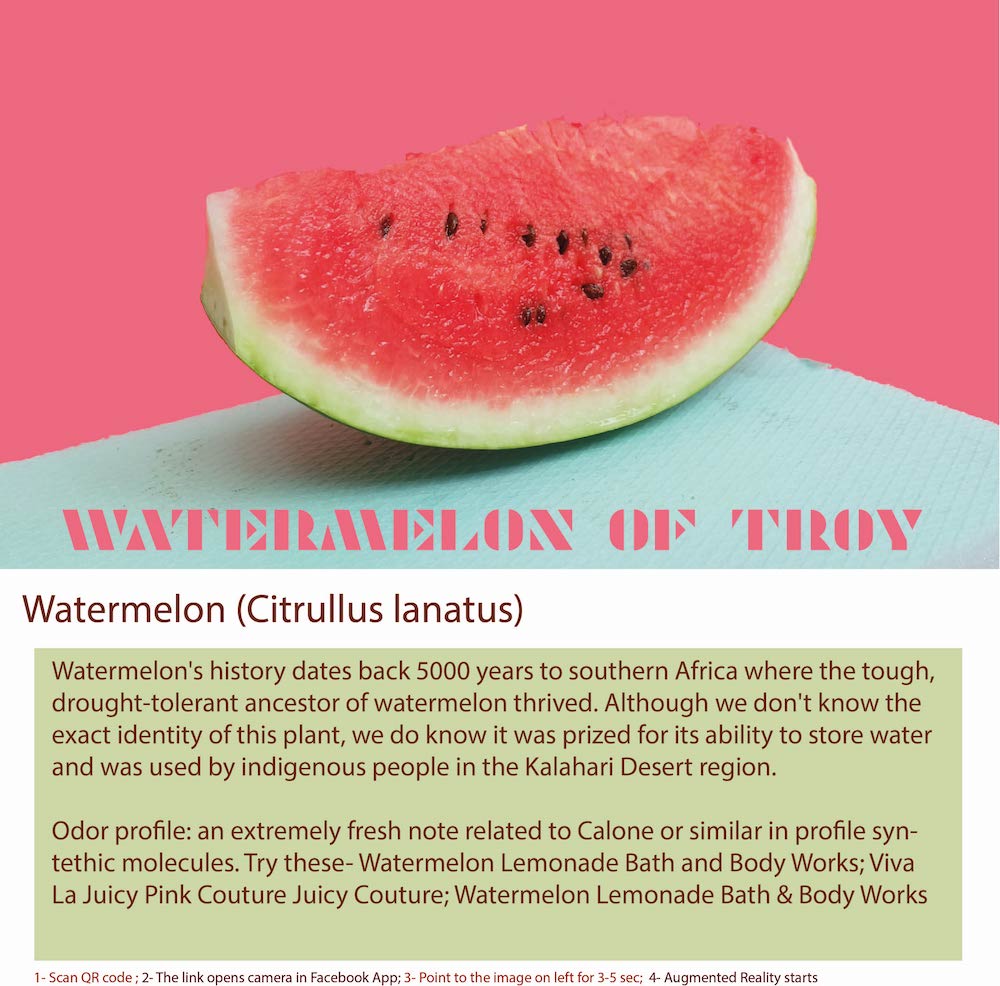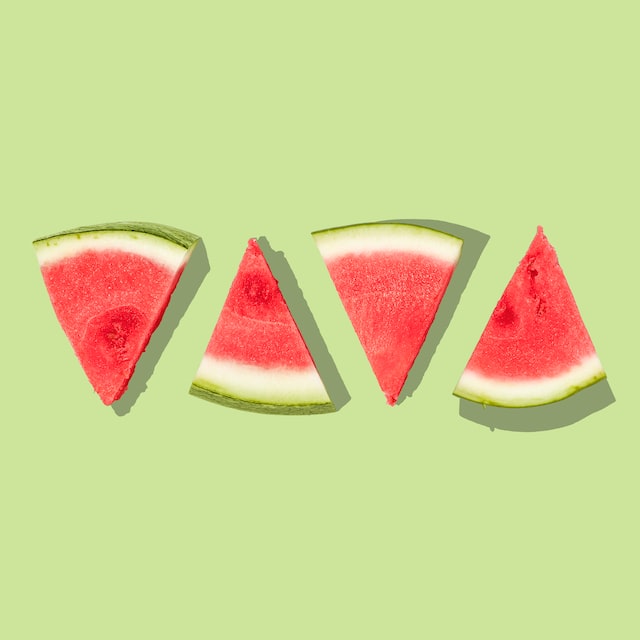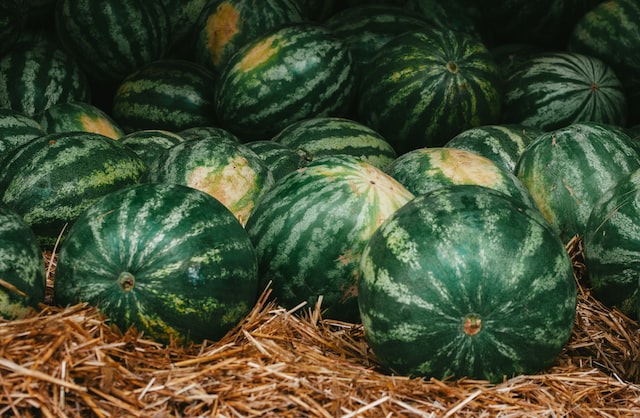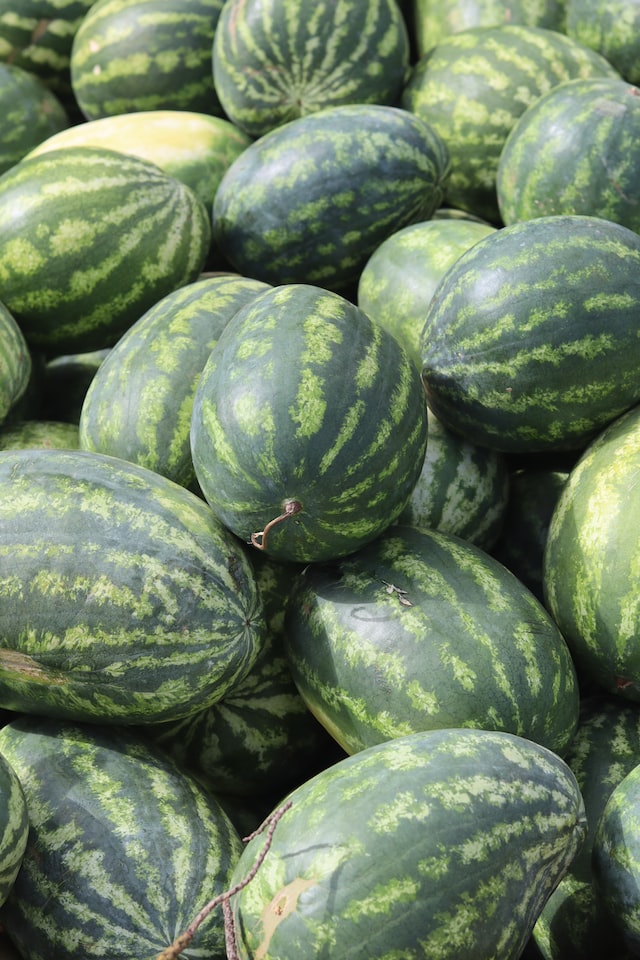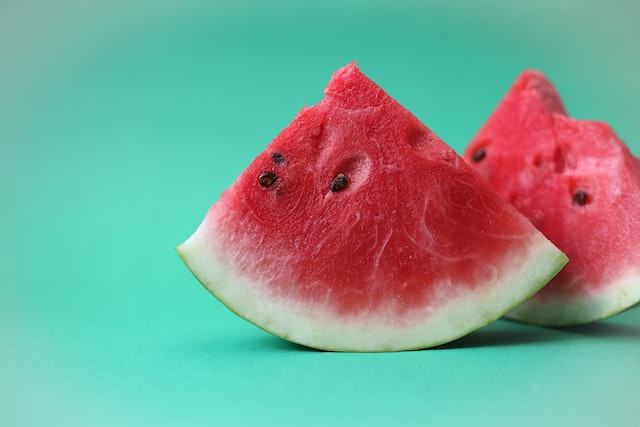Experience the Essence of Watermelon with Our Fragrance Collection
Watermelon: The Juicy Delight of Culinary Delights, Fragrance, and Fun Facts
Introduction: Watermelon, with its juicy and refreshing sweetness, is a beloved fruit celebrated for its presence in culinary delights, fragrance, and intriguing fun facts. Scientifically known as Citrullus lanatus, watermelon is a vine-like flowering plant that belongs to the Cucurbitaceae family. Originating from Africa, watermelon has become a popular fruit worldwide, loved for its hydrating properties and delightful taste. From inspiring perfumers with its aromatic allure to offering potential health benefits and fascinating facts, watermelon is more than just a summer treat. This essay delves into the captivating world of watermelon, encompassing its presence in perfumes, therapeutic oils, culinary creations, medicinal systems, historical significance, and intriguing fun facts about this extraordinary and cherished fruit.
Watermelon in Perfumes and Fragrance: While watermelon itself is not commonly used in perfumes, its delightful fruity aroma may serve as an inspiration for perfumers in creating scents that evoke a sense of summer and freshness.
Therapeutic Oils and Medicinal Properties: Watermelon seed oil, extracted from the seeds of the fruit, is used in some skincare products due to its potential moisturizing and nourishing properties for the skin.
Culinary Delights: Watermelon is a versatile fruit used in various culinary creations. It is a popular ingredient in fruit salads, smoothies, juices, and desserts, offering a refreshing and hydrating addition to dishes.
Nutritional Value and Health Benefits: Watermelon is rich in vitamins, minerals, and antioxidants, such as vitamin C and lycopene. It is hydrating and may have potential benefits for heart health, skin health, and digestion.
Medicinal Uses in Traditional Systems: In traditional medicine systems, watermelon has been used for its potential diuretic properties and as a remedy for certain digestive issues.
Historical Significance: Watermelon has a long history, with evidence of its cultivation dating back to ancient Egypt. Over the centuries, it has become a symbol of summertime and is enjoyed during festive occasions in various cultures.
Fun and Crazy Facts:
Watermelon, with its juicy sweetness and potential health benefits, is a cherished and versatile fruit that continues to captivate and delight people around the world. From its presence in culinary delights to its potential therapeutic uses and fascinating fun facts, watermelon offers a wealth of enjoyment and potential wellness benefits. As we savor the refreshing taste and explore its historical significance and intriguing facts, we are reminded of the simple pleasures and natural wonders that enrich our lives and culinary traditions. Watermelon is more than just a summer treat; it is a symbol of joy and a delightful reminder of the vibrant diversity of nature's bounty.
Introduction: Watermelon, with its juicy and refreshing sweetness, is a beloved fruit celebrated for its presence in culinary delights, fragrance, and intriguing fun facts. Scientifically known as Citrullus lanatus, watermelon is a vine-like flowering plant that belongs to the Cucurbitaceae family. Originating from Africa, watermelon has become a popular fruit worldwide, loved for its hydrating properties and delightful taste. From inspiring perfumers with its aromatic allure to offering potential health benefits and fascinating facts, watermelon is more than just a summer treat. This essay delves into the captivating world of watermelon, encompassing its presence in perfumes, therapeutic oils, culinary creations, medicinal systems, historical significance, and intriguing fun facts about this extraordinary and cherished fruit.
Watermelon in Perfumes and Fragrance: While watermelon itself is not commonly used in perfumes, its delightful fruity aroma may serve as an inspiration for perfumers in creating scents that evoke a sense of summer and freshness.
Therapeutic Oils and Medicinal Properties: Watermelon seed oil, extracted from the seeds of the fruit, is used in some skincare products due to its potential moisturizing and nourishing properties for the skin.
Culinary Delights: Watermelon is a versatile fruit used in various culinary creations. It is a popular ingredient in fruit salads, smoothies, juices, and desserts, offering a refreshing and hydrating addition to dishes.
Nutritional Value and Health Benefits: Watermelon is rich in vitamins, minerals, and antioxidants, such as vitamin C and lycopene. It is hydrating and may have potential benefits for heart health, skin health, and digestion.
Medicinal Uses in Traditional Systems: In traditional medicine systems, watermelon has been used for its potential diuretic properties and as a remedy for certain digestive issues.
Historical Significance: Watermelon has a long history, with evidence of its cultivation dating back to ancient Egypt. Over the centuries, it has become a symbol of summertime and is enjoyed during festive occasions in various cultures.
Fun and Crazy Facts:
- State Fruit of Oklahoma: Watermelon is the state vegetable of Oklahoma, USA, recognized for its economic and cultural significance in the region.
- World Records: Watermelons have been the subject of various world records, including the heaviest watermelon ever grown and the most significant number of watermelons smashed with the head in a minute.
- All Edible: Every part of the watermelon is edible, including the seeds and rind. Roasted watermelon seeds are a popular snack in some cultures.
- High Water Content: Watermelon is about 92% water, making it a highly hydrating fruit, especially during hot weather.
- Different Varieties: Watermelon comes in various varieties, including seedless, yellow-fleshed, and icebox (smaller-sized) watermelons.
Watermelon, with its juicy sweetness and potential health benefits, is a cherished and versatile fruit that continues to captivate and delight people around the world. From its presence in culinary delights to its potential therapeutic uses and fascinating fun facts, watermelon offers a wealth of enjoyment and potential wellness benefits. As we savor the refreshing taste and explore its historical significance and intriguing facts, we are reminded of the simple pleasures and natural wonders that enrich our lives and culinary traditions. Watermelon is more than just a summer treat; it is a symbol of joy and a delightful reminder of the vibrant diversity of nature's bounty.
To experience augmented reality, please open the Facebook-app using QR code and point to the image below
Refreshing Watermelon Fragrance for a Unique Sensory Experience
Watermelon is a juicy and sweet fruit that belongs to the Cucurbitaceae family. It is typically round or oblong in shape, and has a hard green rind on the outside and a juicy red or pink flesh on the inside. Watermelon is a great source of hydration, vitamins, and minerals, and is a popular summer fruit that is enjoyed both fresh and in various recipes such as juices, salads, and desserts.
Watermelon is believed to have originated in the Kalahari Desert of Africa over 5,000 years ago. It was then spread across the world by traders and explorers, eventually reaching the Mediterranean region, where it became a staple food of the ancient Egyptians. The fruit was also consumed by the ancient Greeks and Romans, and was later introduced to the Americas by African slaves and European settlers. Today, watermelon is widely cultivated around the world and is enjoyed as a refreshing and healthy fruit.
Watermelon has a long history of cultivation and breeding. The first evidence of watermelon cultivation dates back to ancient Egypt, where it was considered a valuable food source and was depicted in hieroglyphics and paintings. Over time, people in different regions of the world began to breed watermelons to create varieties with desirable traits such as larger size, sweeter flesh, and thicker rinds.
In the 20th century, breeding and cultivation practices for watermelon were further developed, leading to the creation of new varieties that were more disease-resistant and easier to grow. Today, there are hundreds of different watermelon varieties, each with its own unique characteristics, and the fruit is grown on a large scale in countries around the world, from the United States to China to Brazil. Breeding and cultivation of watermelon continues to evolve, with the goal of creating new varieties that are even more delicious, healthy, and sustainable.
Watermelon is a popular fruit in Singapore, but there is limited information available on its history in the country. It is likely that watermelon was introduced to Singapore by traders and settlers from other countries, and has since become a staple fruit in local markets and supermarkets. Today, watermelon is widely consumed in Singapore for its sweet and juicy flesh, and is often enjoyed as a refreshing snack or used in various recipes such as juices and salads.
Watermelon is believed to have originated in the Kalahari Desert of Africa over 5,000 years ago. It was then spread across the world by traders and explorers, eventually reaching the Mediterranean region, where it became a staple food of the ancient Egyptians. The fruit was also consumed by the ancient Greeks and Romans, and was later introduced to the Americas by African slaves and European settlers. Today, watermelon is widely cultivated around the world and is enjoyed as a refreshing and healthy fruit.
Watermelon has a long history of cultivation and breeding. The first evidence of watermelon cultivation dates back to ancient Egypt, where it was considered a valuable food source and was depicted in hieroglyphics and paintings. Over time, people in different regions of the world began to breed watermelons to create varieties with desirable traits such as larger size, sweeter flesh, and thicker rinds.
In the 20th century, breeding and cultivation practices for watermelon were further developed, leading to the creation of new varieties that were more disease-resistant and easier to grow. Today, there are hundreds of different watermelon varieties, each with its own unique characteristics, and the fruit is grown on a large scale in countries around the world, from the United States to China to Brazil. Breeding and cultivation of watermelon continues to evolve, with the goal of creating new varieties that are even more delicious, healthy, and sustainable.
Watermelon is a popular fruit in Singapore, but there is limited information available on its history in the country. It is likely that watermelon was introduced to Singapore by traders and settlers from other countries, and has since become a staple fruit in local markets and supermarkets. Today, watermelon is widely consumed in Singapore for its sweet and juicy flesh, and is often enjoyed as a refreshing snack or used in various recipes such as juices and salads.
Scentopia Singapore: Your Destination for Quality Fruity Perfumes
Watermelon has been featured in art and literature throughout history, reflecting its cultural significance and popularity as a fruit. In ancient Egyptian art, for example, watermelon is depicted as a symbol of abundance and fertility, and was often shown being offered to gods and pharaohs. In literature, watermelon has been a recurring theme in poems, stories, and songs, often as a symbol of summertime and leisure.
In more recent times, watermelon has continued to appear in art and literature, sometimes as a straightforward depiction of the fruit, and sometimes as a metaphor or symbol. For example, in American popular culture, watermelon is often used to evoke images of rural life, summertime, and southern hospitality, and has been featured in paintings, photographs, and songs. Overall, watermelon's enduring popularity and cultural significance are reflected in its numerous appearances in art and literature throughout history.
Watermelon has been associated with a variety of cultural and symbolic meanings throughout history. Some of the most common associations include:
In more recent times, watermelon has continued to appear in art and literature, sometimes as a straightforward depiction of the fruit, and sometimes as a metaphor or symbol. For example, in American popular culture, watermelon is often used to evoke images of rural life, summertime, and southern hospitality, and has been featured in paintings, photographs, and songs. Overall, watermelon's enduring popularity and cultural significance are reflected in its numerous appearances in art and literature throughout history.
Watermelon has been associated with a variety of cultural and symbolic meanings throughout history. Some of the most common associations include:
- Summertime and leisure: In many cultures, watermelon is seen as a quintessential summer fruit, and its bright red flesh and juicy sweetness are often used to evoke images of lazy afternoons spent by the pool or at the beach.
- Abundance and fertility: In ancient Egypt, watermelon was seen as a symbol of abundance and fertility, and was often depicted in paintings and hieroglyphics being offered to gods and pharaohs.
- Rural life and southern hospitality: In American popular culture, watermelon is often associated with rural life and southern hospitality, and is sometimes used to evoke images of simpler times and a more relaxed way of life.
- Innocence and naivety: In some cultures, watermelon is seen as a symbol of innocence and naivety, often because of its bright, playful appearance and its association with childhood and summertime.
Key Benefits of Watermelon
Watermelon juice is a refreshing and hydrating beverage that can provide a number of health benefits. Some of the key benefits of watermelon juice include:
- Hydration: Watermelon is made up of over 90% water, making it an excellent source of hydration, especially in the summer months.
- Vitamins and minerals: Watermelon is a good source of vitamins A and C, as well as minerals like potassium and magnesium, which are important for overall health.
- Antioxidants: Watermelon contains antioxidants like lycopene and Vitamin C, which help protect cells from damage and may reduce the risk of chronic diseases like heart disease and cancer.
- Anti-inflammatory effects: Some studies suggest that compounds found in watermelon may have anti-inflammatory effects, which could be beneficial for reducing the risk of certain chronic diseases.
Fun Facts about Watermelon
Here are some fun facts about watermelon:
- Watermelon is considered a fruit and a vegetable: Botanically, watermelon is a fruit because it develops from the ovary of a flower and contains seeds. However, it is often considered a vegetable due to its culinary uses.
- Watermelon is the world's largest fruit: The largest watermelon on record weighed over 350 pounds!
- Watermelon is over 90% water: This is why it is an excellent source of hydration, especially in hot weather.
- There are over 1,200 different varieties of watermelon: From small personal-sized watermelons to large oblong varieties, there are many different types of watermelon to choose from.
- Watermelon is a great source of antioxidants: Watermelon contains antioxidants like lycopene and Vitamin C, which help protect cells from damage.
- Watermelon is a versatile fruit: It can be enjoyed on its own, in recipes like salads and juices, or even grilled or pickled.
- Watermelon is low in calories: With only 46 calories per cup, watermelon is a great choice for those who are watching their calorie intake.
Explore Our Fruity Collection - Watermelon Perfume and More
Watermelon has a sweet, fruity scent that is characteristic of ripe melons. The scent is a combination of the natural sugars found in the fruit, along with various volatile organic compounds (VOCs) that are released as the fruit ripens. Some of the key VOCs found in watermelon include alcohols, aldehydes, esters, and terpenes. These compounds give watermelon its distinct sweet, fruity aroma that is familiar to many people.
The scent of watermelon can vary depending on the variety of the fruit and the stage of ripeness. For example, unripe watermelons will have a more muted, green aroma, while overripe watermelons may have a more fermented or pungent scent. Overall, the scent of watermelon is an important indicator of its quality and ripeness, and can play a role in determining whether or not a melon is good to eat.
Watermelon has a unique scent profile that is due to a combination of various chemical compounds found in the fruit. Some of the key chemical compounds found in watermelon that contribute to its scent include:
The scent of watermelon can vary depending on the variety of the fruit and the stage of ripeness. For example, unripe watermelons will have a more muted, green aroma, while overripe watermelons may have a more fermented or pungent scent. Overall, the scent of watermelon is an important indicator of its quality and ripeness, and can play a role in determining whether or not a melon is good to eat.
Watermelon has a unique scent profile that is due to a combination of various chemical compounds found in the fruit. Some of the key chemical compounds found in watermelon that contribute to its scent include:
- Alcohols: Watermelon contains various alcohols, including hexanol, 2-ethyl-1-hexanol, and 3-methyl-1-butanol, which give the fruit a fresh, floral aroma.
- Aldehydes: Aldehydes, such as hexanal and nonanal, contribute to the fruity, sweet aroma of watermelon.
- Esters: Esters, such as ethyl butyrate and ethyl hexanoate, are responsible for the sweet, fruity notes in the scent of watermelon.
- Terpenes: Terpenes, such as limonene and geraniol, are volatile compounds that are found in many fruits and contribute to their scents.
Popular Perfumes with Watermelon
Here is a list of some popular perfumes with a watermelon scent note:
- Marc Jacobs Daisy Dream
- Aquolina Pink Sugar
- Juicy Couture Viva La Juicy
- Escada Island Kiss
- Tommy Hilfiger Tommy Girl
- Banana Republic Wildbloom
- Prada Candy
- Giorgio Armani Acqua di Gioia
- Marc Jacobs Daisy
- Burberry Brit Rhythm for Her.
Join Scentopia, Sentosa's latest tourist attraction wonderful orchid scent crafting, fragrance tour, bridal shower or corporate team building which includes perfume making onsite and offsite, beach activities and more. We also serve primary school learning journey, secondary students and pupil on industrial excursions. Know more about our orchids perfume bar or therapeutic orchid scents and other wellness aromas. Conatct Perfume workshop or book a scent crafting session here.

